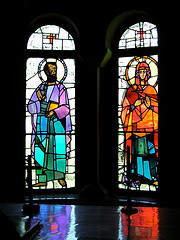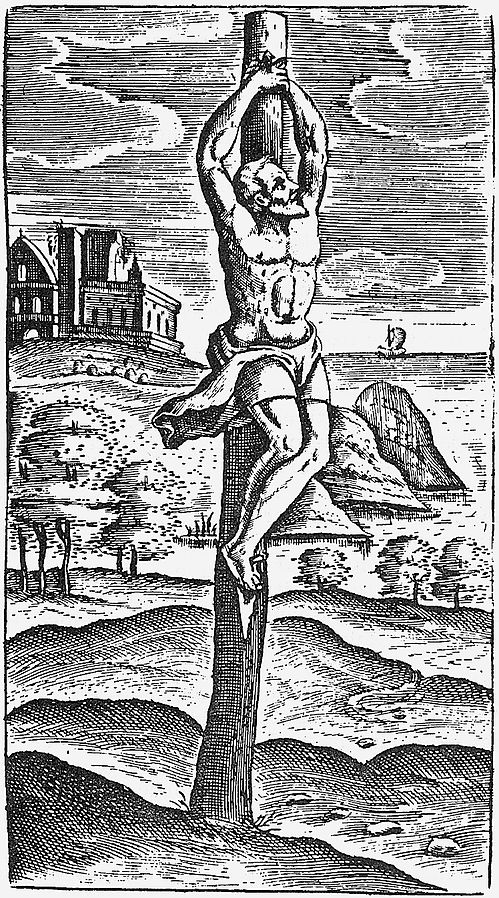In a recent post I discussed Borg’s and Crossan’s attempt in The First Paul to demonstrate (through a bit of good old fundamentalist style “proof-texting”) that Paul’s gospel was essentially an anti-imperialist polemic. An obvious question to ask — and thanks to Keith for raising it — is how this sits with Romans 13 where Paul issues his well-known command for all readers to “be subject to the governing authorities, for there is no authority except from God, and the authorities that exist are appointed by God.” (Romans 13:1)
In my reply to Keith I had to confess that I am not persuaded that Romans 13:1-7 was original to Paul’s letter (Winsome Munro argues that it is part of a series of interpolations by “the Pastoralist”) but still, I had to check back on what Borg and Crossan say about it.
Here it is. Firstly, they insist that Romans 13:1-7 must not be read in isolation but within the context of Romans 12:14 to 13:10. Fair enough. I’m willing to try that.
But then I discover I’ve been tricked. B and C tell me not only to read the Romans passage in the context of a wider Romans passage, they actually go further, once I start, to tell me to read the Romans passage in the context of Matthew’s Sermon on the Mount, written some decades after Paul’s letter! Reading Romans in the context of Matthew is NOT reading Romans in context!
I am reminded once again of the jig-saw games fundamentalists play with the scriptures to justify any doctrine that happens to be the core tradition of whatever particular church! “Here a little, there a little. . . “, a passage drawn from Isaiah to justify flagrant decontextualizing of texts to create any-which doctrine one chooses.
Here’s how B’s and C’s argument goes:
1. Romans 12:14 tells readers to bless their persecutors, and Matthew 5:44 says much the same.
2. Skip now to Romans 12:21. “Do not be overcome with evil, but overcome evil with good.” If we are reading Romans forwards, B & C ask us to read Matthew backward to make the anachronistic parallel work. We are to compare Romans 12:21 with Matthew 5:39, “Do not repay anyone evil for evil.”
What would scholars say about “parallelomania” if any fundies attempted an argument like this!?
3. Then we come to Romans 13:1-7, the passage threatening any reader who disobeys the powers of government with being guilty of rebelling against the decree of God himself! To what is this a parallel in the Sermon on the Mount? Same verse as above, Matthew 5:39. How does that work? By digging out a Greek lexicon and finding meanings to parts of words that can lend support to translating them with a new nuance to do with “violent protest” that you never suspected was there from any traditional translation.
4. B and C find lines in the Liddell & Scott Greek lexicon (“the major Greek lexicon”) that the word for “resist” can be used in reference to a battle where soldiers are commanded to “oppose, withstand”. Their conclusion? “In Matthew 5:39, therefore, it means ‘to resist violently.'”
Only one or two or more problems with that explanation. It runs against the very next sentence in Matthew 5:39 where an example makes it very plain what Jesus meant here. “If anyone slaps you on one cheek, turn to him the other.” Jesus is clearly commanding something more positive than mere “non-violent resistance‘. We know what follows — give more to the one who sues you, go the extra mile for the one who compels you to go one mile. So B and C’s pedantic reliance on selective lines from Liddell and Scott is exposed as a falsehood.
B and C are scholars of the highest rank yet are writing here as charlatans!
Their arguments ring as false as Keller’s in my previous set of posts on his book.
I also checked how else the same word for resist (anti + histemi) is translated in other NT passages. One can consult them: Luke 21:15, Acts 6:10 and 13:8, Galatians 2:11, Ephesians 6:13, 2 Titus 3:8 and 2 Timothy 4:15, James 4:7, 1 Peter 5:9. Those interested can discover how often the word really does mean “violent resistance”.
5. B and C continue: “If anti + histemi is redolent of (military) violence (vridar: we have just seen this is hardly so from the above examples) anti + tasso is even more so.” (page 119).
The word in question here? “One must be subject . . .” (Romans 13:5).
How on earth can B & C possibly take a word that in context means clearly “subjection to an authority” to be “even more” redolent of “violent resistance”?! The Liddell & Scott lexicon to which they turn includes a meaning like “to set opposite to, range in battle against” — I would suggest from the context that here the emphasis is on soldiers submitting to their commanders’ orders to hold fast against the enemy. Those interested can do their own study of this Greek word in the Crosswalk Lexicon here.
6. The final parallelomania, sorry, “parallel” is the word used by B&C, is when we move on in Romans 13 to verses 8-10 and compare these with, no, not still reading backwards in Matthew, but forwards again this time, back to where we started in verse 44: Love your enemies. But this time, we are given even more parallels — Luke somewhere says the same thing! This (comparing Romans 13:8-10 with Matthew and Luke from decades after Paul) is all to help us understand the context of Romans 13:1-7!
Sure enough, Romans 13:8-10 talks about Loving one’s . . . Sorry, no. Start again. . . .
While Matthew 5:44 talks about loving one’s enemies, Romans 13:1-7 talks about loving one’s neighbours! And this is used as a “parallel” that will help us understand that Romans 13:1-7 is really about the same thing as Matthew saying somewhere that we should turn the other cheek and go the extra mile — Woops, sorry, I mean, this is really about the same thing as Matthew saying we should not “resist violently”! — Even though that Greek word clearly does not mean that most other times it is used in the New Testament. Nor does it mean that in Romans 13:1-7.
7. B and C in this way conclude that Paul in Romans 13:1-7 is “most afraid, not that Christians will be killed but that they will kill” to avoid paying taxes! “It is something that appalls him so much that — in rather a rhetorical panic (vridar: did anyone else detect a panicked tone in Rom 13:1-7??) — he makes some very unwise and unqualified statements with which to ward off that possibility.” (p. 120)
Yet B and C have just spent the last page or two trying to argue from parallels with Matthew and Luke and from selected lines in a Greek lexicon (not from other NT contextual uses of the words) that Paul was meaning exactly what he wrote! So which way do B and C mean us to take his words?
If Borg and Crossan excuse themselves for such shoddy and untenable “exegesis” because their book is for the public and not fellow scholars (few of whom would probably ever read it anyway), then I suggest they are treating their public with contempt.
This is clearly dishonest exegesis of Romans 13:1-7 from scholars of such a calibre that they really have no excuse.
Footnote:
There is a YouTube video of Crossan and Borg discussing atheism. Crossan uses a similar pedantic argument to assert that atheists are really fixated on God. His case? The word “a-theist” contains “theist”, meaning God, so if they are “a-theists” then they are fixated on God! Hoo boy! Maybe his best days are over and we should just be reading his earlier stuff?



